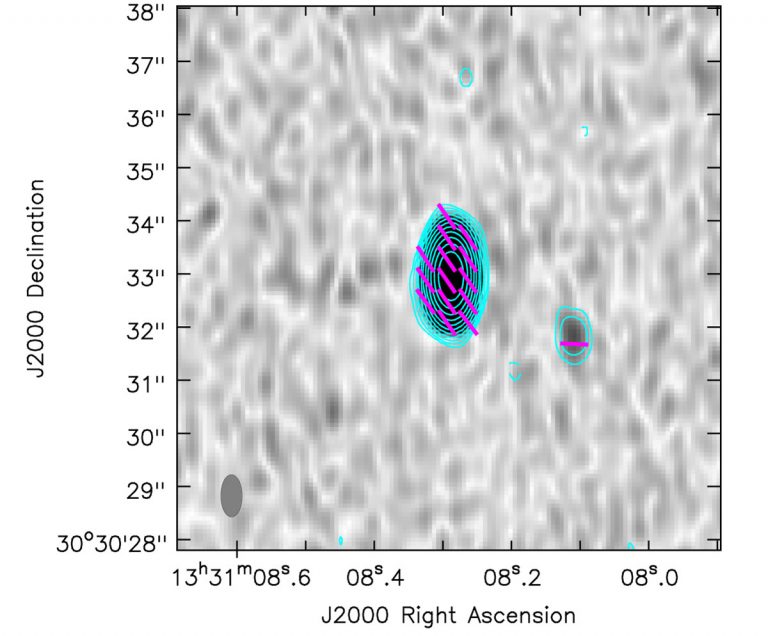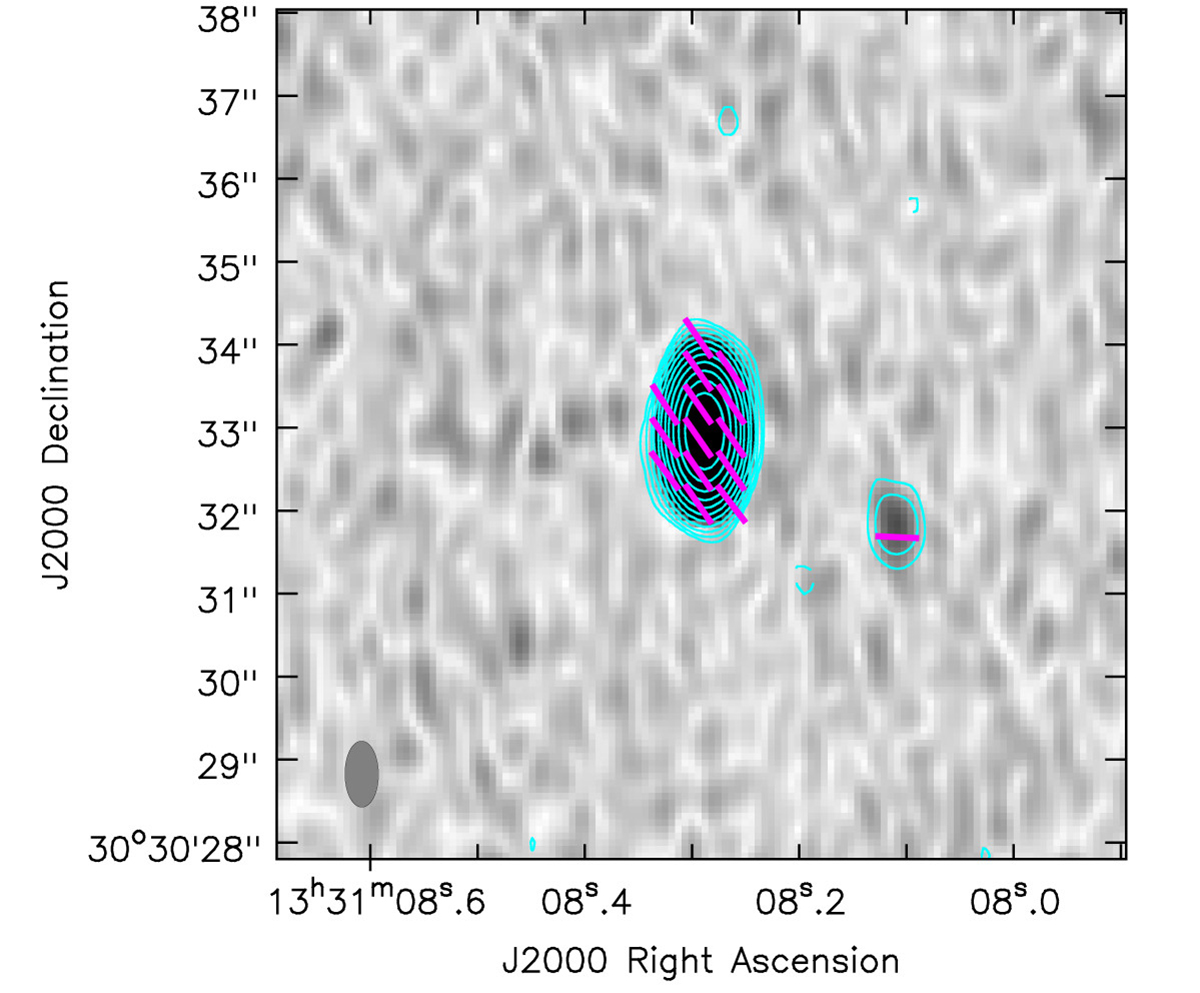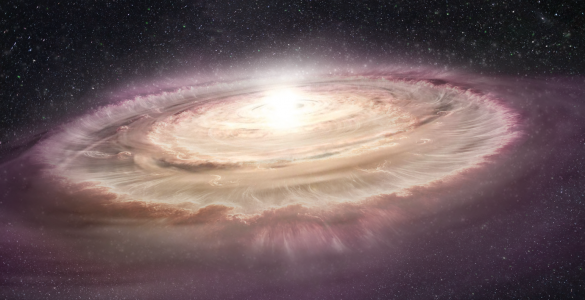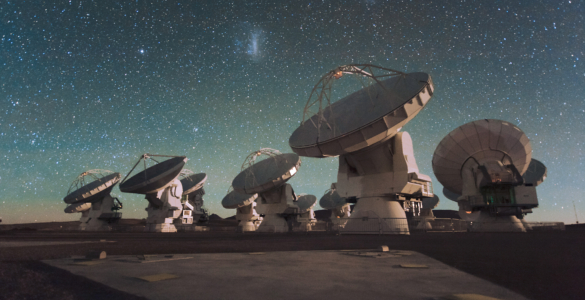ALMA’s first full-polarization observations demonstrate its capacity for doing polarimetry
Recent observations have confirmed that ALMA’s excellent sensitivity and calibration accuracy make it a top-class instrument for performing polarimetric measurements at millimeter wavelengths.
Even though ALMA (the Atacama Large Millimeter/submillimeter Array) has been operating since 2011, observations are continuing to verify key aspects of its performance. ALMA was designed to perform sensitive polarimetry — measuring the polarization of radio waves to reveal the properties of magnetic fields — and astronomers have recently reported the first full-polarization observations with ALMA, confirming that it is excellently suited to this task.
To do this, astronomers observed the bright source 3C 286, quasar located approximately 7.3 billion light-years from Earth. This object is a very powerful source of radio waves and has been observed by many other telescopes. The radio emission from 3C 286 is known to be highly polarized, making it an ideal candidate to test ALMA’s capabilities in this area. The ALMA observations reveal details not seen before and clearly show that the magnetic field is stronger and more ordered toward the inner region of the jet that emerges from the quasar. This helps researchers to understand the magnetic field structure in the very heart of the quasar, furnishing vital clues about the physical processes that give rise to the radio emission.
“This observation has certainly verified the high capability of the polarimetry observation with ALMA,” said Hiroshi Nagai at the National Astronomical Observatory of Japan and the leader of the verification team. “This is an important milestone for the ALMA project.”
Magnetic fields are important in many cosmic situations but they are very difficult to measure. Polarimetry is one of the few methods able to reveal details of magnetic fields. However, the polarized component of the radio waves — the part measured in polarimetry — may only be a few percent of the total radio flux from an object, and therefore high sensitivity is essential to carry out precise polarimetry. ALMA has the sensitivity needed to make these crucial polarimetric observations, as this latest study has confirmed.
More Information
These results were published in the Astrophysical Journal on 20 June 2016 in a paper titled “ALMA Science Verification Data: Millimeter Continuum Polarimetry of the Bright Radio Quasar 3C 286” by H. Nagai et al.
The first scientific results containing ALMA full polarization data were published by the Astrophysical Journal Letters on June 30, 2016, as “Interferometric Mapping Of Magnetic Fields: The Alma View Of The Massive Star-Forming Clump W43-MM1” by Cortés et al.
The team is composed of: H. Nagai (National Astronomical Observatory of Japan, Tokyo, Japan), K. Nakanishi (National Astronomical Observatory of Japan, Tokyo, Japan; The Graduate University for Advanced Studies, Tokyo, Japan; Joint ALMA Observatory, Santiago, Chile), R. Paladino (INAF-Osservatorio di Radioastronomia, Bologna, Italy), C.L.H. Hull (Harvard-Smithsonian Center for Astrophysics, Cambridge, Massachusetts, USA; Jansky Fellow of the National Radio Astronomy Observatory), P. Cortes (Joint ALMA Observatory, Santiago, Chile; National Radio Astronomy Observatory, Charlottesville, Virginia, USA), G. Moellenbrock (National Radio Astronomy Observatory, Socorro, New Mexico, USA), E. Fomalont (Joint ALMA Observatory, Santiago, Chile; National Radio Astronomy Observatory, Charlottesville, Virginia, USA), K. Asada (The Academia Sinica Institute of Astronomy and Astrophysics, Taipei, Taiwan) and K. Hada (National Astronomical Observatory of Japan, Tokyo, Japan).
The Atacama Large Millimeter/submillimeter Array (ALMA), an international astronomy facility, is a partnership of ESO, the U.S. National Science Foundation (NSF) and the National Institutes of Natural Sciences (NINS) of Japan in cooperation with the Republic of Chile. ALMA is funded by ESO on behalf of its Member States, by NSF in cooperation with the National Research Council of Canada (NRC) and the National Science Council of Taiwan (NSC) and by NINS in cooperation with the Academia Sinica (AS) in Taiwan and the Korea Astronomy and Space Science Institute (KASI).
ALMA construction and operations are led by ESO on behalf of its Member States; by the National Radio Astronomy Observatory (NRAO), managed by Associated Universities, Inc. (AUI), on behalf of North America; and by the National Astronomical Observatory of Japan (NAOJ) on behalf of East Asia. The Joint ALMA Observatory (JAO) provides the unified leadership and management of the construction, commissioning and operation of ALMA.
Contacts:
Hiroshi Nagai
National Astronomical Observatory of Japan
Email: hiroshi.nagai@nao.ac.jp
Charles Blue
NRAO, Public Information Officer
434-296-0314; cblue@nrao.edu




















